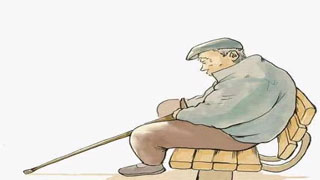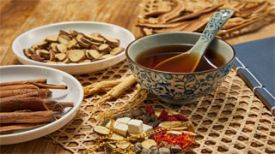
The yin and yang of the human body are represented by yang on the back and yin on the abdomen. When it comes to the yin and yang in the hidden body of a person, then the hidden body is yin and the hidden body is yang. The liver, heart, spleen, lungs, and kidneys are all yin, while the gallbladder, stomach, large intestine, small intestine, bladder, and Sanjiao are all yang. So what is it to know the yin within yin and the yang within yang? Winter diseases are in Yin, summer diseases are in Yang, spring diseases are in Yin, and autumn diseases are in Yang, all of which are considered as the location of acupuncture. Therefore, the back is yang, the yang in the yang, and the heart is also; Back is yang, yin in yang, lungs are also; The abdomen is yin, yin within yin, and the kidneys are also yin; The abdomen is yin, yang in yin, and the liver; The abdomen is yin, the middle of yin is yin, and the spleen is also yin. This is the correspondence between the internal and external male and female in the Yin Yang table, so it corresponds to the Yin Yang of heaven—— Huangdi Neijing, Suwen, Jinkuizhen Commentary Chapter Four
The Yellow Emperor's Inner Canon in this passage talks about the Earth's image, which refers to the human back, spine, and well-developed muscles located in the back. The entire back of the human body is also particularly hard. We see an interesting thing that when people encounter danger, a protective instinct is to hold their heads with both hands, hide their heads in their chest and abdomen, and expose their entire back. After encountering an emergency situation, everyone holds their heads and bends their backs, hiding their entire stomachs and exposing their backs to the outside. Because the back is relatively hard and masculine, it is not easily damaged. Compared to the abdomen, this is the yang face. Collect the dark side well. So, this is an instinctive reaction of the human body.
Animals like to sunbathe in spring and summer. Because the back is the Yang meridian and the Du meridian. The last time I went to a temple in Beijing - Hongluo Temple. Hongluo Temple has a release pond with many turtles in it. I remember it was the transition between spring and summer at that time. At noon, all the turtles crawled onto the shore to sunbathe, motionless and letting the sun directly shine on them, in order to receive the yang energy. The back belongs to Yang, and through sun exposure, all meridians on the back are opened up, and Yang energy is unblocked. So, the back is yang and the abdomen is yin.
The commentary in Volume 1 of the "Collection of Annotations on Su Wen" states: "At the beginning of a woman's life, she was born with a negative yang and embraced yin, with her back as yang and her abdomen as yin. The governor's pulse follows her back, and her body is yang. The Ren's pulse follows her abdomen, and she unites the yin of any body." Therefore, whether it is Zhang Jiebin's annotation of the "Lei Jing" or Zhang Zhicong's collection of annotations on the "Su Wen Collection Annotations" and "Ling Shu Collection Annotations" that he gathered his disciples to annotate together, they are all collections of the "Yellow Emperor's Inner Canon". When these two explanations are combined, they actually mean that the human body is a small world with the concept of yin and yang. That's easy to understand. The back is yang and the abdomen is yin. There are yin and yang in the human body's internal organs, which are stored. As I just mentioned, they are the five organs, meaning to collect and pass on things without storing them. The six viscera are always directed outward and will not hide. The food we eat enters the stomach, large intestine, and small intestine, and the water we drink enters the bladder, all of which are excreted and released. The dynamic process is yang, the static process, and the collection process are yin, which are the five organs. This makes it easier to understand.
The phrase 'To know the yin within yin and the yang within yang' is relatively difficult to understand. The so-called "winter disease is in yin, summer disease is in yang, spring disease is in yin, and autumn disease is in yang" is stated in Ma Shi's "Su Wen Zhu Zheng Fa Wei": "Winter is yin, and winter disease is in the yin meridian, so we should know that there is yin in yin; summer is yang, and summer disease is in the yang meridian, so we should know that there is yang in yang; spring is not far from winter, and its disease is still in the yin meridian; autumn is not far from summer, and its disease is still in the yang meridian. Each person considers the location of their disease, which is the stone ear for needle application." The meaning of this paragraph is based on the changes in the four seasons of spring, summer, autumn, and winter. The sentence is:. Winter belongs to Yin, and winter diseases occur in the Yin meridian, which is called winter diseases in Yin. Xia belongs to Yang, so summer diseases are in Yang. Why is Spring Disease in Yin? Because after winter comes spring, not far from winter. Spring is not far from winter, and its illness still lies in the Yin meridian. Therefore, spring illness lies in the Yin meridian. Autumn is not far from summer, and its illness is still in the Yang meridian. So, autumn in the sun, this is an understanding. The book "Su Wen Zhi Jie" is written by Gao Shibai. He was a disciple of Zhang Zhicong and a renowned physician of the Qing Dynasty. He explained: "In the following text, the yin in the cloud is the kidney. In the summer, the disease is in the yang, and in the heart. In the following text, the yang in the cloud is the heart. Knowing that winter disease is in the yin and summer disease is in the yang, then knowing the yin in the yin and the yang in the yang. Spring disease is in the yin, and autumn disease is in the yang." This is how he understood it.
Spring disease lies in yin, liver is also. In the following text, the yang in yin refers to the liver. Autumn disease lies in yang, lung is also. In the following text, the yin in cloud yang refers to the lung. The liver is the yang in yin, but it is called yin, so it is clear that yang is in yin. The lung is the yin in yang, but it is called yang, so it is clear that yin is in yang. Knowing that spring disease is in yin and autumn disease is in yang, then knowing that yang is in yin and yin is in yang. "This passage is based on the following text," Therefore, the back is yang, yang is in yang, heart is also; the back is yang, yin is in yang, lung is also. "Therefore, in winter, it belongs to the kidney. Summer belongs to the heart, so winter is yin and summer is yang, there is no dispute about this. Spring is yin, spring belongs to the liver, and the liver is the yang in yin. So, we need to clarify the yang within the yin here. Autumn belongs to the lungs, which are the yin of yang. So, as we know before, 'What is it that wants to know the yin within yin and the yang within yang?' Actually, it refers to these two organs, one is the liver and the other is the lungs, which are respectively the yang within yin and the yin within yang. This paragraph is easy to understand, connecting the context. In fact, according to the annotations, I personally think that the paragraph annotated in Gao Shibai Zong's "Suwen Zhijie" is more reliable and easier for people to understand. This is the meaning of yin in the preceding and following text, and yin in the middle of yang.
According to the principle of "all people regard the location of the disease as the stone for applying acupuncture", that is to say, acupuncture and moxibustion, stone needle or drug therapy should be carried out according to the location of the disease. Therefore, the back is yang, and the yang within the yang is also the heart. "The back is yang, and the yang within the yang is the heart. The back is yang, and the yin in yang is the lungs. So the heart and lungs are located in the upper part of the human body, in the upper part of the organs. The position of the five organs, the heart and lungs, is in the chest cavity. The chest and back are connected, so the yang in the yang is the heart, and the yin in the yang is the lungs. This is how it is divided. The abdomen is the stomach, the yin in the yin is the kidney, and the yang in the yin is the liver. Why is the yang in the yin the liver? Because the liver has a sign of ascending, both of these are easy to understand.
What is the most difficult to understand? It is the ultimate yin in yin, which is the spleen. Why is it said that the most important element in yin is the spleen? Because the spleen is an acquired foundation among the five organs, it is the collection of all things. All the things we eat are transported and distributed throughout the body through the spleen, which is precisely the middle of yin. So it's called the Foot Taiyin Spleen Meridian. In the future, we will specifically discuss the Foot Tai Yin Spleen Meridian, which is also included in the six meridians differentiation of the Treatise on Cold Damage. So it is called the ultimate yin in yin.
Disclaimer: This article is a sharing of health knowledge. The drugs, prescriptions, acupuncture and moxibustion and other treatment and health preserving methods mentioned in this article should be applied under the guidance of professional doctors, and should not be applied by yourself. We are not responsible for any issues arising from improper use.


